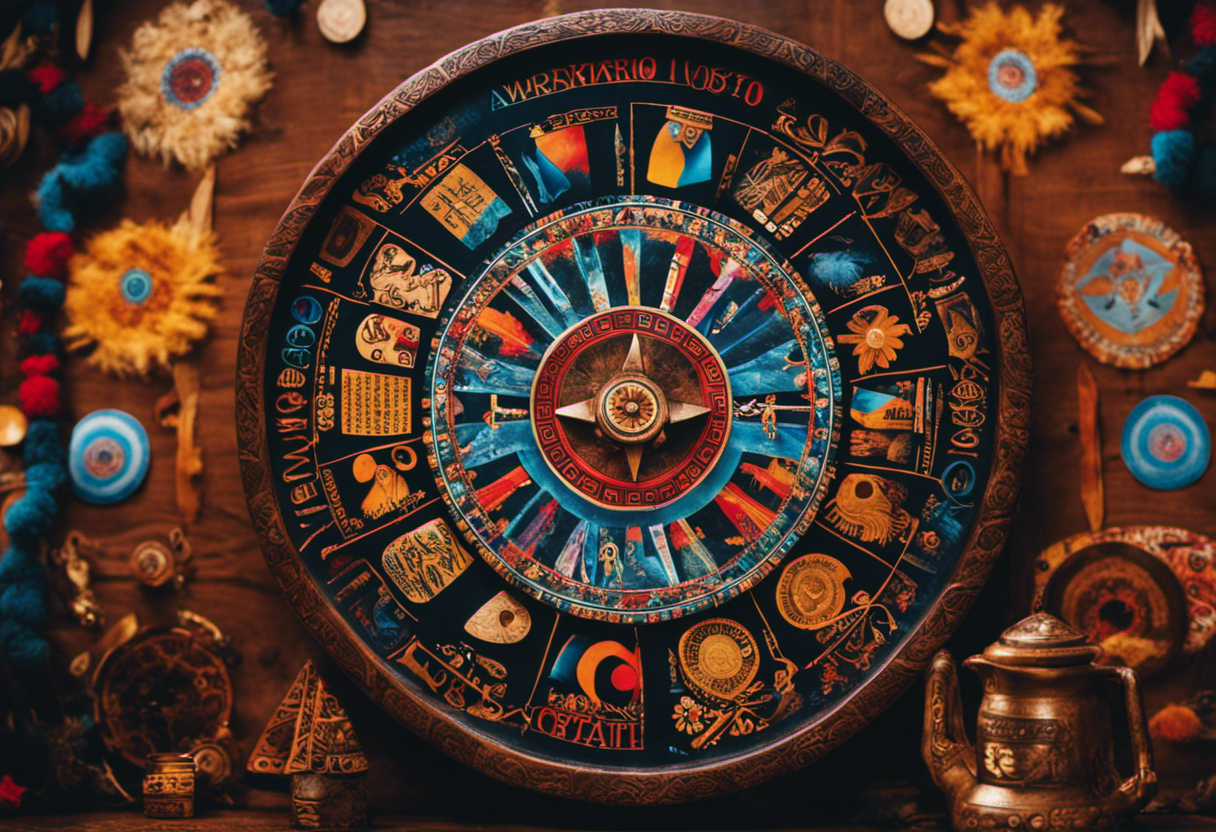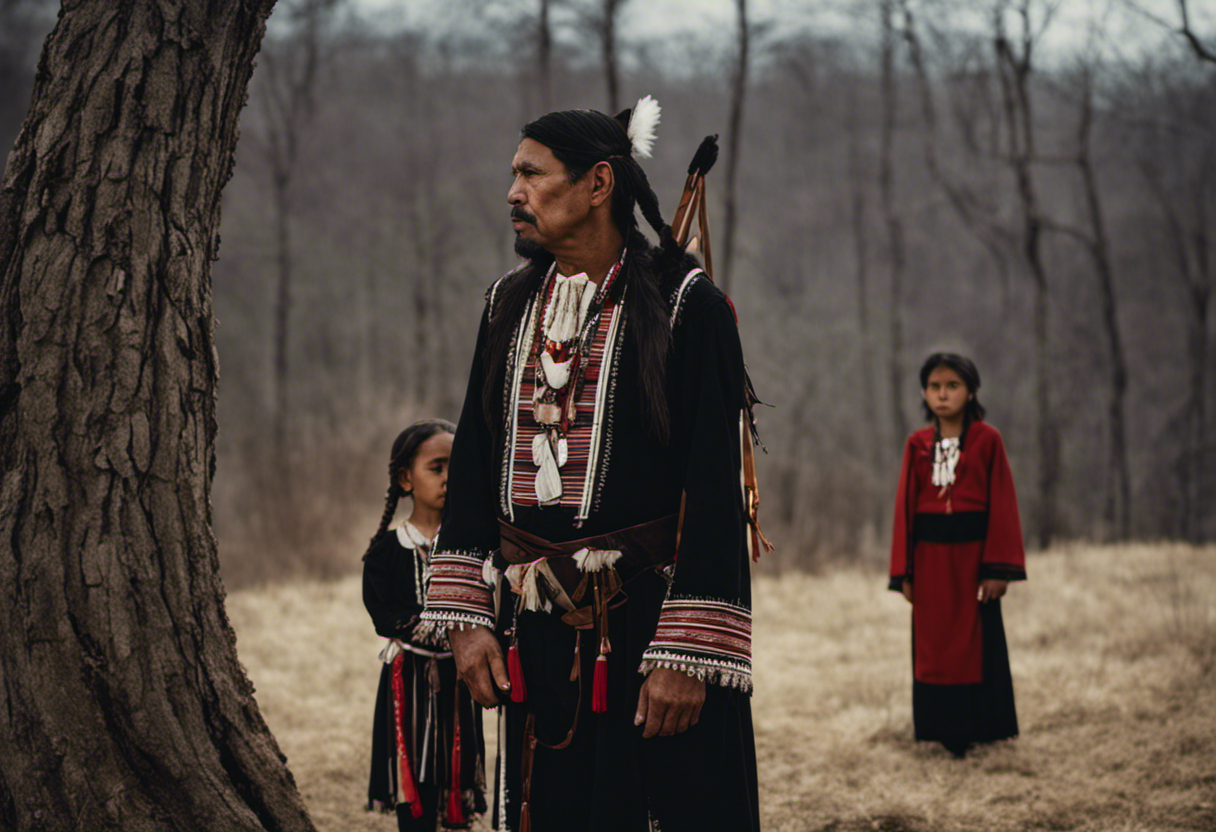While some may dismiss the significance of the Cherokee Calendar as mere folklore, its importance cannot be underestimated. This article delves into the rich and ancient traditions of the Cherokee people, exploring how their calendar system not only honors their ancestors but also serves as a testament to their resilience in the face of immense adversity, such as the Trail of Tears.
Through rigorous research and interdisciplinary analysis, we aim to shed light on the profound role that the Cherokee Calendar plays in preserving their cultural heritage.
Key Takeaways
- The Cherokee calendar serves as a method of honoring ancestors and preserving cultural heritage.
- It reminds the Cherokee people of the painful history of the Trail of Tears and commemorates the sacrifices made by their ancestors.
- The calendar is based on lunar cycles, agricultural practices, and cultural events, and engages in traditional activities and rituals passed down through generations.
- By preserving and honoring their cultural heritage, the Cherokee calendar strengthens community bonds and promotes a sense of identity among the Cherokee people.
The Significance of the Cherokee Calendar


The Cherokee Calendar holds great cultural significance as it not only serves as a method of honoring ancestors but also serves as a reminder of the painful history of the Trail of Tears.
Understanding traditions and their cultural significance is vital for preserving a community’s heritage and promoting a sense of identity. The Cherokee people have a deep-rooted connection to their ancestors and believe that their spirits continue to guide and protect them. The Cherokee Calendar plays a crucial role in this understanding and serves as a tangible link to their past.
The Cherokee Calendar is a complex system that encompasses various elements such as lunar cycles, agricultural practices, and cultural events. It is based on the observation of celestial bodies, particularly the moon, and serves as a guide for daily life, ceremonies, and social gatherings. By following the calendar, the Cherokee people honor their ancestors by engaging in traditional activities and rituals that have been passed down through generations.
Furthermore, the Cherokee Calendar also serves as a reminder of the painful history of the Trail of Tears. This tragic event, which forcibly relocated thousands of Cherokee people from their ancestral lands to territories in the west, is etched into the collective memory of the Cherokee Nation. By incorporating references to the Trail of Tears in their calendar, the Cherokee people ensure that future generations never forget the sacrifices and hardships endured by their ancestors.
Understanding the Traditional Cherokee Months


The traditional Cherokee calendar consists of twelve months, each with its own unique significance and rituals. Understanding the traditional Cherokee months is essential for preserving and honoring the cultural heritage of the Cherokee people.
Seasonal Significance and Rituals
Seasonal significance and rituals play a crucial role in the Cherokee calendar, serving as a way to honor ancestors and commemorate the painful history of the Trail of Tears. The Cherokee people have a deep connection to the natural world and believe that the changing seasons bring about spiritual transformations. Through their seasonal celebrations and traditional practices, they express gratitude for the gifts of nature and seek harmony with the universe.
The Cherokee New Year, known as the Great New Moon Ceremony, marks the beginning of the agricultural cycle and is a time of renewal and purification.
The Green Corn Ceremony, held in late summer, is a time of thanksgiving for the corn harvest and a celebration of community and abundance.
The Fall Festival, also known as the Gathering of the People, is a time to honor the ancestors and reflect on their sacrifices.
The Winter Solstice, marked by the Cherokee as the Time of Renewal, is a time of introspection and renewal of spiritual energy.
These seasonal rituals serve as a way for the Cherokee people to connect with their past, honor their ancestors, and find solace in the face of the hardships they have endured.
Cultural Preservation and Heritage
Cultural preservation and heritage play a vital role in maintaining the traditions and values of the Cherokee people, ensuring that their rich history and cultural identity continue to thrive.
The Cherokee have a strong commitment to preserving their cultural heritage, which includes traditional practices, rituals, and customs that have been passed down through generations. These cultural practices are considered sacred and are an integral part of the Cherokee way of life. They provide a sense of belonging and identity for the Cherokee people, strengthening their community bonds and fostering a deep connection to their ancestral roots.
Through cultural heritage preservation efforts, the Cherokee people are able to honor their ancestors and keep their traditional practices alive. This not only benefits the present generation but also ensures that future generations will continue to have a connection to their cultural heritage and the values it embodies.
Commemorating Ancestors Through Sacred Ceremonies


Commemorating ancestors through sacred ceremonies is a deeply rooted tradition in many cultures around the world. These ceremonies serve as a way to honor and remember the contributions and wisdom of those who came before us.
Through these rituals, communities come together to pay tribute to their ancestors, seeking guidance, protection, and a connection to their cultural heritage.
Significance of Sacred Ceremonies
Sacred ceremonies in the Cherokee calendar hold great significance as they provide a means for honoring ancestors and paying homage to the tragic history of the Trail of Tears. These ceremonies serve as a vital link between the past, present, and future generations of the Cherokee people. Through these rituals, the Cherokee people express their deep respect for their ancestors and ensure that their memories are not forgotten.
The significance of these sacred ceremonies can be seen in the emotional impact they evoke:
- Reflection: Ceremonies provide a space for introspection and contemplation, allowing individuals to connect with their ancestral roots and reflect on the hardships faced by their predecessors.
- Healing: Engaging in sacred rituals helps individuals find solace and healing, both individually and as a community, as they navigate the complex emotions associated with the Trail of Tears.
- Unity: These ceremonies foster a sense of unity among the Cherokee people, reinforcing their shared history and cultural identity.
- Resilience: Participating in these ceremonies serves as a testament to the Cherokee people’s resilience and determination to preserve their culture and honor their ancestors.
Through the sacred ceremonies of the Cherokee calendar, ancestral remembrance becomes a powerful tool for healing, unity, and resilience within the Cherokee community.
Role of Ancestors’ Remembrance
The role of ancestors’ remembrance is a fundamental aspect of Cherokee culture. It recognizes the profound influence and ancestral connection that shapes the present and future. The Cherokee people believe that their ancestors continue to exist in the spiritual realm and play an active role in guiding and protecting their descendants.
Through rituals, ceremonies, and storytelling, the Cherokee maintain a strong connection to their ancestors. They seek wisdom and guidance from their spirits. This remembrance serves as a source of strength, identity, and cultural continuity within the Cherokee community.
Moreover, the recognition of ancestors’ influence fosters a sense of collective responsibility and intergenerational harmony. By honoring their ancestors, the Cherokee ensure the preservation of their cultural heritage. They maintain a deep respect for their historical struggles and triumphs.
Overall, the role of ancestors’ remembrance is a vital element in the Cherokee’s spiritual and cultural practices.
The Trail of Tears and Its Impact on the Cherokee Calendar


The forced relocation of Cherokee tribes during the Trail of Tears significantly influenced the structure and significance of the Cherokee calendar. This tragic event, marked by immense suffering and loss, had a profound impact on the Cherokee people’s culture and collective memory. The Cherokee calendar, which had previously been a tool for tracking seasons and agricultural activities, became a means of honoring ancestors and commemorating the historical trauma experienced during the Trail of Tears.
The Trail of Tears not only disrupted the lives of the Cherokee people but also shattered their cultural practices and traditions. The Cherokee calendar, as a result, underwent significant changes to reflect this new reality. Here are four ways in which the Trail of Tears impacted the Cherokee calendar:
- The calendar began to incorporate specific dates to remember and honor those who perished during the forced relocation.
- Certain ceremonies and rituals previously associated with agricultural activities were adapted to acknowledge the historical trauma experienced during the Trail of Tears.
- The calendar became a symbol of resilience and resistance, reminding the Cherokee people of their enduring spirit in the face of adversity.
- The importance of collective remembrance and community support became integral to the calendar, as the Cherokee people sought solace and strength in their shared experiences.
The Trail of Tears forever altered the Cherokee calendar, transforming it into a tool for cultural preservation and healing. It serves as a powerful reminder of the resilience and strength of the Cherokee people in the face of historical trauma.
The Role of the Cherokee Calendar in Healing and Resilience


The Cherokee calendar plays a significant role in the healing practices and resilience strategies of the Cherokee people. It serves as a guiding framework for understanding the cyclical nature of life, honoring ancestors, and fostering a sense of community and connection.
Healing practices within the Cherokee culture are deeply rooted in spiritual beliefs and traditions. The calendar provides a structured system for recognizing important ceremonies and rituals that promote healing, both individually and collectively. For instance, the Green Corn Ceremony, held in late summer, is a time of purification and renewal, where participants seek healing and restoration of balance in their lives. By following the calendar, the Cherokee people are able to engage in these healing practices and maintain a connection to their cultural heritage.
Resilience strategies are also embedded within the Cherokee calendar. The calendar serves as a reminder of the strength and resilience of the Cherokee people, who have endured numerous hardships throughout their history, such as the Trail of Tears. By acknowledging and honoring their ancestors through the calendar, the Cherokee people draw upon their collective resilience and find inspiration to overcome challenges and adversity.
Honoring Ancestors: Rituals and Practices in the Cherokee Calendar


Rituals and practices within the Cherokee calendar provide a means for the preservation of cultural heritage and the acknowledgment of ancestral wisdom. The Cherokee people have a deep respect for their ancestors and believe that their spirits continue to guide and protect them. Through the observance of specific rituals and practices, the Cherokee calendar serves as a powerful tool for honoring and remembering their ancestors.
- Sacred Fire Ceremonies: The lighting of a sacred fire is a central ritual in the Cherokee calendar. It symbolizes the connection between the physical and spiritual realms and serves as a way to communicate with the ancestors.
- Feast Days: Feast days are a time for the community to come together and give thanks for the blessings bestowed upon them. These gatherings involve the preparation and sharing of traditional foods, music, dance, and storytelling.
- Medicine Plant Gatherings: The Cherokee have a deep knowledge of the healing properties of plants. Medicine plant gatherings are held to collect and prepare herbs for medicinal purposes. This practice not only honors the ancestors’ wisdom but also helps to preserve traditional healing practices.
- Ancestor Remembrance: Throughout the year, the Cherokee calendar designates specific days for honoring and remembering ancestors. These occasions involve ceremonies, prayers, and offerings to ensure the continued guidance and protection of their spirits.
The rituals and practices within the Cherokee calendar serve as a vital link to the past, allowing the Cherokee people to maintain their cultural identity and honor the wisdom and guidance of their ancestors.
Preserving and Passing on the Cherokee Calendar Traditions
Preserving and passing on the traditions of the Cherokee calendar ensures the continuation of cultural heritage and the transmission of ancestral knowledge. The Cherokee calendar, deeply rooted in the history and culture of the Cherokee people, is a vital aspect of their identity and spirituality. It serves as a guide to understanding important celestial events, agricultural practices, and the interconnectedness of all living beings.
Preserving these traditions requires a concerted effort to document and record the teachings associated with the calendar. This involves the collaboration of elders, historians, linguists, and anthropologists to ensure accurate and comprehensive documentation. By doing so, future generations can access this knowledge and continue the legacy of the Cherokee calendar.
Passing on this knowledge is equally crucial. It involves the active participation of Cherokee communities, particularly through educational programs and cultural events. These initiatives aim to engage younger generations, instill a sense of pride in their heritage, and encourage them to embrace and carry forward the traditions of the calendar.
The transmission of ancestral knowledge includes not only the technical aspects of the calendar, such as the identification and interpretation of celestial events, but also the values, stories, and spiritual beliefs associated with it. This interdisciplinary approach ensures a holistic understanding of the calendar, firmly grounding it in the cultural fabric of the Cherokee people.
Conclusion
In conclusion, the Cherokee calendar holds immense significance in honoring ancestors and preserving cultural traditions. Its understanding of the traditional Cherokee months and the commemoration of ancestors through sacred ceremonies serve as a testament to the resilience of the Cherokee people.
Despite the devastating impact of the Trail of Tears, the Cherokee calendar continues to play a crucial role in healing and maintaining a connection with the past. By preserving and passing on these traditions, the Cherokee people ensure the longevity of their rich cultural heritage.




